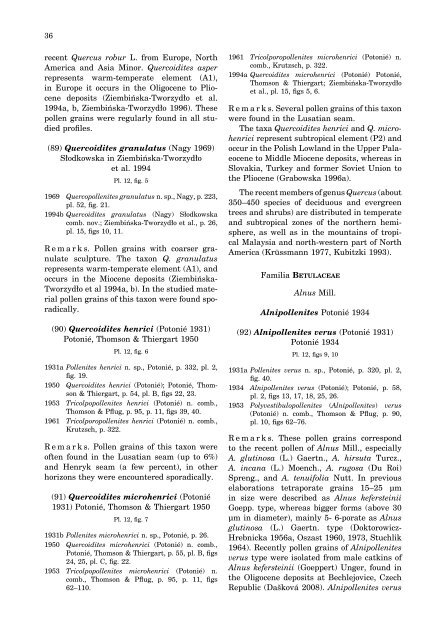Middle Miocene palynoflora of the Legnica lignite deposit complex ...
Middle Miocene palynoflora of the Legnica lignite deposit complex ...
Middle Miocene palynoflora of the Legnica lignite deposit complex ...
You also want an ePaper? Increase the reach of your titles
YUMPU automatically turns print PDFs into web optimized ePapers that Google loves.
36<br />
recent Quercus robur L. from Europe, North<br />
America and Asia Minor. Quercoidites asper<br />
represents warm-temperate element (A1),<br />
in Europe it occurs in <strong>the</strong> Oligocene to Pliocene<br />
<strong>deposit</strong>s (Ziembińska-Tworzydło et al.<br />
1994a, b, Ziembińska-Tworzydło 1996). These<br />
pollen grains were regularly found in all studied<br />
pr<strong>of</strong>i les.<br />
(89) Quercoidites granulatus (Nagy 1969)<br />
Słodkowska in Ziembińska-Tworzydło<br />
et al. 1994<br />
Pl. 12, fi g. 5<br />
1969 Quercopollenites granulatus n. sp., Nagy, p. 223,<br />
pl. 52, fi g. 21.<br />
1994b Quercoidites granulatus (Nagy) Słodkowska<br />
comb. nov.; Ziembińska-Tworzydło et al., p. 26,<br />
pl. 15, fi gs 10, 11.<br />
R e m a r k s. Pollen grains with coarser granulate<br />
sculpture. The taxon Q. granulatus<br />
represents warm-temperate element (A1), and<br />
occurs in <strong>the</strong> <strong>Miocene</strong> <strong>deposit</strong>s (Ziembińska-<br />
Tworzydło et al 1994a, b). In <strong>the</strong> studied material<br />
pollen grains <strong>of</strong> this taxon were found sporadically.<br />
(90) Quercoidites henrici (Potonié 1931)<br />
Potonié, Thomson & Thiergart 1950<br />
Pl. 12, fi g. 6<br />
1931a Pollenites henrici n. sp., Potonié, p. 332, pl. 2,<br />
fi g. 19.<br />
1950 Quercoidites henrici (Potonié); Potonié, Thomson<br />
& Thiergart, p. 54, pl. B, fi gs 22, 23.<br />
1953 Tricolpopollenites henrici (Potonié) n. comb.,<br />
Thomson & Pfl ug, p. 95, p. 11, fi gs 39, 40.<br />
1961 Tricolporopollenites henrici (Potonié) n. comb.,<br />
Krutzsch, p. 322.<br />
R e m a r k s. Pollen grains <strong>of</strong> this taxon were<br />
<strong>of</strong>ten found in <strong>the</strong> Lusatian seam (up to 6%)<br />
and Henryk seam (a few percent), in o<strong>the</strong>r<br />
horizons <strong>the</strong>y were encountered sporadically.<br />
(91) Quercoidites microhenrici (Potonié<br />
1931) Potonié, Thomson & Thiergart 1950<br />
Pl. 12, fi g. 7<br />
1931b Pollenites microhenrici n. sp., Potonié, p. 26.<br />
1950 Quercoidites microhenrici (Potonié) n. comb.,<br />
Potonié, Thomson & Thiergart, p. 55, pl. B, fi gs<br />
24, 25, pl. C, fi g. 22.<br />
1953 Tricolpopollenites microhenrici (Potonié) n.<br />
comb., Thomson & Pfl ug, p. 95, p. 11, fi gs<br />
62–110.<br />
1961 Tricolporopollenites microhenrici (Potonié) n.<br />
comb., Krutzsch, p. 322.<br />
1994a Quercoidites microhenrici (Potonié) Potonié,<br />
Thomson & Thiergart; Ziembińska-Tworzydło<br />
et al., pl. 15, fi gs 5, 6.<br />
R e m a r k s. Several pollen grains <strong>of</strong> this taxon<br />
were found in <strong>the</strong> Lusatian seam.<br />
The taxa Quercoidites henrici and Q. microhenrici<br />
represent subtropical element (P2) and<br />
occur in <strong>the</strong> Polish Lowland in <strong>the</strong> Upper Palaeocene<br />
to <strong>Middle</strong> <strong>Miocene</strong> <strong>deposit</strong>s, whereas in<br />
Slovakia, Turkey and former Soviet Union to<br />
<strong>the</strong> Pliocene (Grabowska 1996a).<br />
The recent members <strong>of</strong> genus Quercus (about<br />
350–450 species <strong>of</strong> deciduous and evergreen<br />
trees and shrubs) are distributed in temperate<br />
and subtropical zones <strong>of</strong> <strong>the</strong> nor<strong>the</strong>rn hemisphere,<br />
as well as in <strong>the</strong> mountains <strong>of</strong> tropical<br />
Malaysia and north-western part <strong>of</strong> North<br />
America (Krüssmann 1977, Kubitzki 1993).<br />
Familia BETULACEAE<br />
Alnus Mill.<br />
Alnipollenites Potonié 1934<br />
(92) Alnipollenites verus (Potonié 1931)<br />
Potonié 1934<br />
Pl. 12, fi gs 9, 10<br />
1931a Pollenites verus n. sp., Potonié, p. 320, pl. 2,<br />
fi g. 40.<br />
1934 Alnipollenites verus (Potonié); Potonié, p. 58,<br />
pl. 2, fi gs 13, 17, 18, 25, 26.<br />
1953 Polyvestibulopollenites (Alnipollenites) verus<br />
(Potonié) n. comb., Thomson & Pfl ug, p. 90,<br />
pl. 10, fi gs 62–76.<br />
R e m a r k s. These pollen grains correspond<br />
to <strong>the</strong> recent pollen <strong>of</strong> Alnus Mill., especially<br />
A. glutinosa (L.) Gaertn., A. hirsuta Turcz.,<br />
A. incana (L.) Moench., A. rugosa (Du Roi)<br />
Spreng., and A. tenuifolia Nutt. In previous<br />
elaborations tetraporate grains 15–25 μm<br />
in size were described as Alnus kefersteinii<br />
Goepp. type, whereas bigger forms (above 30<br />
μm in diameter), mainly 5- 6-porate as Alnus<br />
glutinosa (L.) Gaertn. type (Doktorowicz-<br />
Hrebnicka 1956a, Oszast 1960, 1973, Stuchlik<br />
1964). Recently pollen grains <strong>of</strong> Alnipollenites<br />
verus type were isolated from male catkins <strong>of</strong><br />
Alnus kefersteinii (Goeppert) Unger, found in<br />
<strong>the</strong> Oligocene <strong>deposit</strong>s at Bechlejovice, Czech<br />
Republic (Dašková 2008). Alnipollenites verus

















